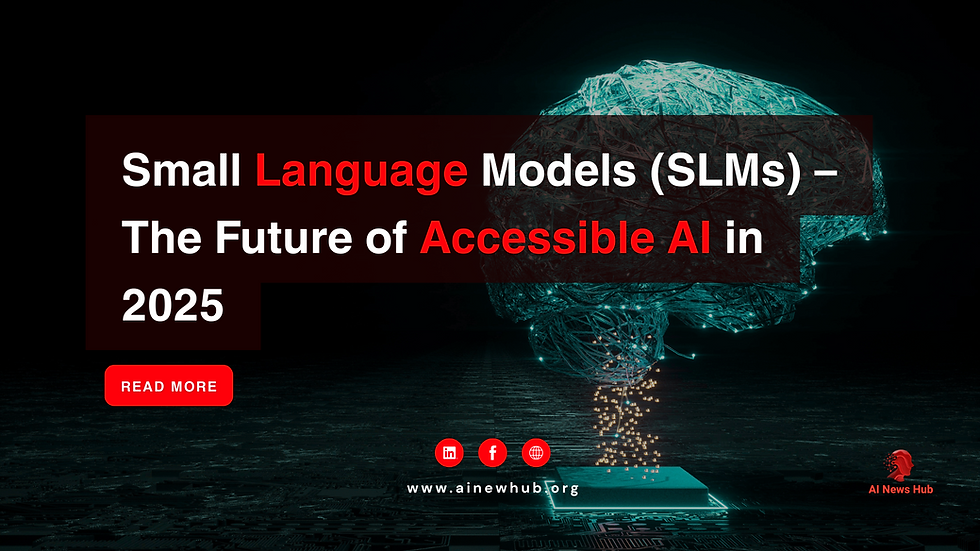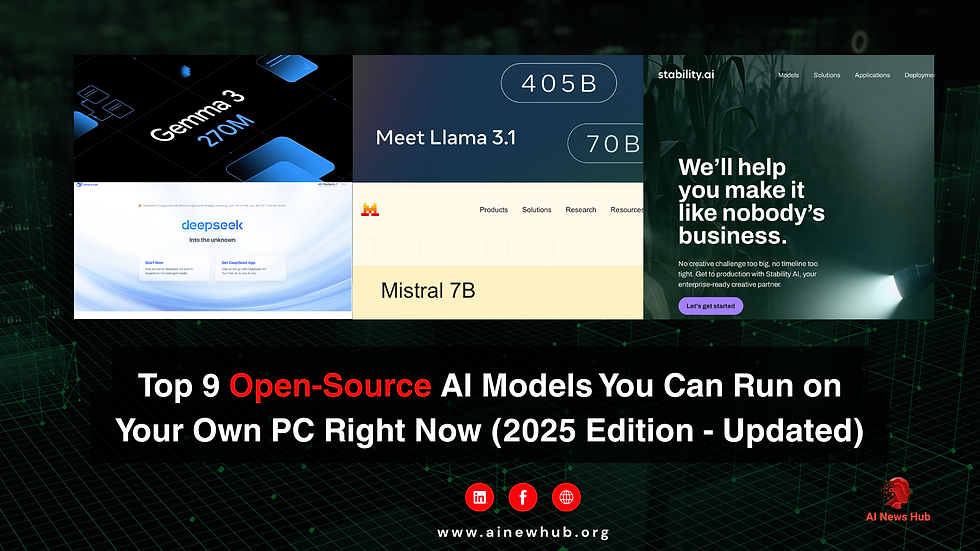Small Language Models (SLMs) – The Future of Accessible AI in 2025
- Talha A.
- Aug 16
- 6 min read

In the dynamic realm of artificial intelligence, Small Language Models (SLMs) are reshaping how we approach AI deployment, emphasizing efficiency and accessibility. As of August 15, 2025, SLMs are gaining momentum for their ability to deliver robust performance on everyday hardware, making AI viable for a broader audience. This blog explores the rise of SLMs, their benefits, applications, key players, challenges, and future prospects. If you're searching for "SLMs future 2025" or "small language models accessible AI," read on for the latest insights backed by industry data.
An Overview of Small Language Models
Small Language Models (SLMs) are compact AI models typically featuring fewer than 10 billion parameters, optimized for low-resource environments like mobile devices and edge computing. Unlike their bulkier counterparts, SLMs focus on efficiency, enabling faster inference and reduced energy consumption while maintaining high utility for targeted tasks.

The market for SLMs is experiencing explosive growth, projected to reach USD 5.45 billion by 2032 from USD 0.93 billion in 2025, growing at a CAGR of 28.5% according to MarketsandMarkets. Another report from Global Market Insights estimates the market at USD 6.5 billion in 2024, with a CAGR of 25.7% through 2034. While IDC forecasts broader AI impacts, such as $22.3 trillion in global economic value from AI solutions by 2030, SLMs are carving out a niche in cost-effective AI adoption. 📈
This surge teases transformative applications in sectors like SMEs, education, and IoT, with leading players such as Meta, Mistral AI, Alibaba's Qwen, and xAI's Grok 3 driving innovation. These models promise to democratize AI, making it accessible beyond big tech.
What Are Small Language Models?
SLMs stand in contrast to Large Language Models (LLMs), which often exceed 175 billion parameters (e.g., GPT-4). SLMs, with parameter counts under 10 billion, prioritize specialization over scale, excelling in niche tasks without demanding massive computational resources.
Key benefits include significantly lower training costs—up to 50% less than LLMs, as highlighted in Forbes analyses—and offline functionality for privacy-sensitive applications. For instance, SLMs require fewer GPUs for training, slashing expenses that can run into millions for LLMs. This efficiency enables deployment on consumer devices, reducing latency and enhancing data security, per industry reports.
The 'How': Key Techniques Behind SLM Efficiency

The magic of SLMs isn't just about training on less data; it's about sophisticated optimization techniques. Innovators are using several key methods to shrink models without sacrificing quality:
Knowledge Distillation: This is a 'student-teacher' approach where a larger, more capable LLM (the teacher) trains a smaller SLM (the student). The student learns to mimic the teacher's outputs, effectively compressing its knowledge into a more efficient form.
Quantization: This technique reduces the precision of the numbers (parameters) within the model, for example, by converting 32-bit floating-point numbers to 8-bit integers. This drastically cuts down the model's size and memory requirements, making it faster on consumer hardware.
Pruning: This involves identifying and removing redundant or unimportant parameters within the model after training, much like trimming away dead branches on a plant. This makes the model lighter and faster without significantly impacting its core performance.
Key Applications
SLMs are unlocking new possibilities across industries, powering efficient AI solutions where resources are limited.
For Small and Medium Enterprises (SMEs): SLMs drive chatbots that handle customer interactions, with trends indicating substantial cost savings—potentially up to millions annually through reduced staffing and improved efficiency, as noted in 2025 AI chatbot trends. Reports suggest AI chatbots could benefit a majority of SMEs by automating support.
In Education: SLMs enable offline AI tutors, particularly in rural areas. India's AI4Bharat program at IIT Madras leverages SLMs for multilingual tools, supporting initiatives like BharatGen, a government-funded multimodal LLM for public services and education.
For IoT: SLMs integrate into smart devices, with global IoT connections expected to reach 18.8 billion in 2025. China leads, enhancing home automation in millions of devices through efficient on-edge processing. China's role is pivotal, with Qwen powering mobile apps for over 2.2 million corporate users via Alibaba's ecosystem.
Personal Productivity and On-Device Assistants: Beyond enterprise use, SLMs are revolutionizing personal productivity. Imagine an email client that summarizes and drafts replies entirely on your laptop, without your private data ever leaving the device. 🛡️ These on-device assistants, powered by SLMs, offer a level of privacy and personalization that cloud-based LLMs cannot match.
Top Players & Models

Leading innovators are propelling SLMs forward with open-source and enterprise-focused models.
Phi-3 series excels in offline AI, widely adopted in open-source projects on platforms like Hugging Face, where it's praised for its lightweight design and performance in reasoning tasks.
Mistral AI's models, like Mistral 7B, target SMEs with a focus on cost-effective, high-quality performance. The company raised €600 million ($645 million) in 2024, boosting its valuation to $6.2 billion.
Alibaba's Qwen series, China's lightweight SLM, integrates into Alibaba's ecosystem, attracting over 90,000 enterprise deployments and 300 million downloads worldwide.
xAI's Grok 3, including the compact Grok 3 Mini, focuses on enterprise tasks like logic-based reasoning, available for efficient deployment on platforms like Azure.
SLMs at a Glance: A 2025 Snapshot
To better understand the landscape, here's a quantitative comparison of leading SLMs available today:
Model Name | Developer | Parameters | Key Strength / Use Case | License | Relative Inference Cost |
Phi-3 Mini | Meta | 3.8×109 | Superior on-device reasoning and language tasks | MIT (Permissive) | Very Low |
Mistral 7B | Mistral AI | 7×109 | High-efficiency for SME & developer applications | Apache 2.0 | Low |
Qwen1.5-7B | Alibaba Cloud | 7×109 | Strong multilingual support & ecosystem integration | Apache 2.0 | Low |
Grok 3 Mini | xAI | ≈8×109 | Advanced logic and complex problem-solving | Proprietary | Low-Medium |
Challenges
Despite their advantages, SLMs face hurdles.
Limited Reasoning: They lag behind LLMs in highly complex, multi-step reasoning tasks. MIT studies showing LLMs themselves overestimate reasoning imply even greater gaps for SLMs—potentially 20% or more in accuracy for intricate problems.
Scalability: Deployment in large, distributed systems presents challenges, particularly in maintaining performance across diverse edge environments.
Funding Gaps: LLMs still capture the majority of AI investments. CB Insights notes SLMs are gaining traction but remain underfunded compared to LLM giants like OpenAI ($19.1B).
The Fine-Tuning Dilemma: While SLMs are cheaper to run, making them perform exceptionally well on a specific task requires high-quality, domain-specific data and expertise. For many SMEs, sourcing this clean data and hiring the talent to properly specialize a model remains a significant barrier.
Future Outlook
Looking ahead, Gartner predicts that 80% of enterprise software and applications will be multimodal by 2030, up from less than 10% in 2024, with SLMs playing a key role. China is investing heavily, with initiatives like China Mobile's $29 billion ecosystem supporting SLM advancements.
A key trend is the rise of Composable AI and Agentic Systems. The future isn't just about single SLMs. We're seeing the emergence of systems where multiple, specialized SLMs work together like a team of experts. One SLM might handle sentiment analysis, another might process order details, and a third could draft a response. This modular approach will allow businesses to build sophisticated, efficient workflows without a monolithic LLM.
Conclusion
SLMs are pivotal in democratizing AI, offering efficient, accessible solutions that bridge the gap between advanced capabilities and real-world constraints. As they evolve from standalone models into a vibrant ecosystem of interconnected specialists, SLMs will empower more users and industries than ever before to harness the true potential of artificial intelligence.
Stay updated with AI News Hub for the latest on SLMs and emerging AI trends. What are your thoughts on SLMs' role in 2025? Share in the comments!
Frequently Asked Questions (FAQs)
What are Small Language Models (SLMs) and how do they differ from Large Language Models (LLMs)?
Small Language Models (SLMs) are compact AI models with fewer than 10 billion parameters, designed for efficiency and accessibility. Unlike Large Language Models (LLMs), which often exceed 175 billion parameters and require massive compute resources, SLMs prioritize speed, low energy use, and deployment on everyday devices.
Why are SLMs considered more efficient for SMEs and startups?
SLMs offer up to 50% lower training and deployment costs compared to LLMs, making them ideal for SMEs and startups with limited budgets. They also require fewer GPUs and can run on consumer-grade hardware, helping smaller organizations access powerful AI tools without multimillion-dollar infrastructure investments.
Can Small Language Models run on mobile devices or edge hardware?
Yes ✅. SLMs are optimized for low-resource environments, meaning they can run on mobile devices, laptops, and IoT hardware. Techniques like quantization, pruning, and knowledge distillation make them lightweight and fast, enabling real-time inference and offline functionality where cloud connectivity is limited.
Which companies are leading in SLM development in 2025?
As of 2025, several companies are pushing SLM innovation:
Meta (Phi-3 series) – lightweight, open-source, on-device AI.
Mistral AI (Mistral 7B) – SME-focused efficiency models.
Alibaba (Qwen series) – multilingual edge AI integrated into Alibaba’s ecosystem.
xAI (Grok 3 Mini) – enterprise-grade reasoning tasks.
What are the key applications of SLMs in education, IoT, and personal productivity?
Education: Offline AI tutors and multilingual learning tools (e.g., India’s AI4Bharat).
IoT: On-device intelligence in smart homes and industrial sensors.
Personal Productivity: AI assistants that summarize emails, draft replies, or perform tasks locally—boosting privacy and responsiveness.






Comments